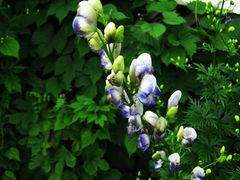Aconitum × cammarum: Difference between revisions
New page: __NOTOC__{{Plantbox | name = ''LATINNAME'' <!--- replace LATINNAME with the actual latin name --> | common_names = <!--- if multiple, list all, if none, leave blank --> | growth_habi... |
No edit summary |
||
| (3 intermediate revisions by the same user not shown) | |||
| Line 1: | Line 1: | ||
{{SPlantbox | |||
| | |familia=Ranunculaceae | ||
| | |genus=Aconitum | ||
| | |species=cammarum | ||
| | |habit=herbaceous | ||
| | |Min ht box=35 | ||
| | |Min ht metric=in | ||
| | |Max ht box=47 | ||
| | |Max ht metric=in | ||
| | |height_ref=perennials.com | ||
| | |Min wd box=18 | ||
| | |Min wd metric=in | ||
| | |Max wd box=23 | ||
| | |Max wd metric=in | ||
| | |width_ref=perennials.com | ||
| | |poisonous=toxic if eaten/harmful via skin | ||
|poison_ref=perennials.com | |||
|lifespan=perennial | |||
|exposure=sun, part-sun | |||
| | |water=moist, moderate | ||
| | |features=flowers, cut flowers | ||
| | |flower_season=mid summer, late summer, early fall | ||
| | |flowers=blue, multicolored, white | ||
| | |Temp Metric=°F | ||
| | |image=IMG 2295a.jpg | ||
| | |image_width=240 | ||
| | |||
| | |||
| | |||
}} | }} | ||
These herbaceous perennial plants are chiefly natives of the mountainous parts of the northern hemisphere, growing in moisture retentive but well draining soils on mountain meadows. Their dark green leaves lack stipules. They are palmate or deeply palmately lobed with 5–7 segments. Each segment again is 3-lobed with coarse sharp teeth. The leaves have a spiral or alternate arrangement. The lower leaves have long petioles. | |||
The tall, erect stem is crowned by racemes of large blue, purple, white, yellow or pink zygomorphic flowers with numerous stamens. They are distinguishable by having one of the five petaloid sepals (the posterior one), called the galea, in the form of a cylindrical helmet; hence the English name monkshood. There are 2–10 petals, in the form of nectaries. The two upper petals are large. They are placed under the hood of the calyx and are supported on long stalks. They have a hollow spur at their apex, containing the nectar. The other petals are small and scale-like or non-forming. The 3–5 carpels are partially fused at the base. | |||
The fruit is a follicle, a follicle being a dry, unilocular, many-seeded fruit formed from one carpel, and dehiscing by the ventral suture in order to release seeds. | |||
{{Inc| | {{Inc| | ||
Aconitum cammarum, Linn. (A. decorum, Reichb. A. exaltatum, Bernh.). St. 3-4 ft.: lvs. with short, bluntish lobes: fls. purple or blue; panicles or loose spikes few-fld; helmet hemispherical, closed. July-Sept. Hungary. Intro. 1889.—A. Storkianum, Reichb., is a dwarf form of this, with fewer fls. and somewhat fibrous roots. | Aconitum cammarum, Linn. (A. decorum, Reichb. A. exaltatum, Bernh.). St. 3-4 ft.: lvs. with short, bluntish lobes: fls. purple or blue; panicles or loose spikes few-fld; helmet hemispherical, closed. July-Sept. Hungary. Intro. 1889.—A. Storkianum, Reichb., is a dwarf form of this, with fewer fls. and somewhat fibrous roots. | ||
{{SCH}} | {{SCH}} | ||
| Line 39: | Line 41: | ||
===Propagation=== | ===Propagation=== | ||
Division, seed. | |||
===Pests and diseases=== | ===Pests and diseases=== | ||
| Line 65: | Line 67: | ||
*{{wplink}} | *{{wplink}} | ||
__NOTOC__ | |||
Latest revision as of 05:12, 13 September 2011
| Aconitum cammarum subsp. var. | ||||||||||||||||||||||||||||||||||||||||||||||||||||||||
|---|---|---|---|---|---|---|---|---|---|---|---|---|---|---|---|---|---|---|---|---|---|---|---|---|---|---|---|---|---|---|---|---|---|---|---|---|---|---|---|---|---|---|---|---|---|---|---|---|---|---|---|---|---|---|---|---|

|
|
| ||||||||||||||||||||||||||||||||||||||||||||||||||||||
| ||||||||||||||||||||||||||||||||||||||||||||||||||||||||
These herbaceous perennial plants are chiefly natives of the mountainous parts of the northern hemisphere, growing in moisture retentive but well draining soils on mountain meadows. Their dark green leaves lack stipules. They are palmate or deeply palmately lobed with 5–7 segments. Each segment again is 3-lobed with coarse sharp teeth. The leaves have a spiral or alternate arrangement. The lower leaves have long petioles.
The tall, erect stem is crowned by racemes of large blue, purple, white, yellow or pink zygomorphic flowers with numerous stamens. They are distinguishable by having one of the five petaloid sepals (the posterior one), called the galea, in the form of a cylindrical helmet; hence the English name monkshood. There are 2–10 petals, in the form of nectaries. The two upper petals are large. They are placed under the hood of the calyx and are supported on long stalks. They have a hollow spur at their apex, containing the nectar. The other petals are small and scale-like or non-forming. The 3–5 carpels are partially fused at the base.
The fruit is a follicle, a follicle being a dry, unilocular, many-seeded fruit formed from one carpel, and dehiscing by the ventral suture in order to release seeds.
| Standard Cyclopedia of Horticulture |
|---|
|
Aconitum cammarum, Linn. (A. decorum, Reichb. A. exaltatum, Bernh.). St. 3-4 ft.: lvs. with short, bluntish lobes: fls. purple or blue; panicles or loose spikes few-fld; helmet hemispherical, closed. July-Sept. Hungary. Intro. 1889.—A. Storkianum, Reichb., is a dwarf form of this, with fewer fls. and somewhat fibrous roots. CH
|
Cultivation
- Do you have cultivation info on this plant? Edit this section!
Propagation
Division, seed.
Pests and diseases
- Do you have pest and disease info on this plant? Edit this section!
Species
Gallery
If you have a photo of this plant, please upload it! Plus, there may be other photos available for you to add.
-
photo 1
-
photo 2
-
photo 3
References
- Standard Cyclopedia of Horticulture, by L. H. Bailey, MacMillan Co., 1963
External links
- w:Aconitum × cammarum. Some of the material on this page may be from Wikipedia, under the Creative Commons license.
- Aconitum × cammarum QR Code (Size 50, 100, 200, 500)
